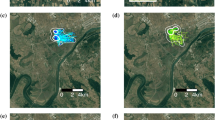Abstract
The Golden jackal is known to have a wide distribution range and has been put under “Least Concern” category in the IUCN (ver 3.1) Red Data Book. However, the species once quite common along with the Bengal Fox in the eighteenth and nineteenth century of Kolkata has faced serious challenge due to land use and land cover changes in their urban habitats. As such, the Golden jackal has become “locally endangered” in the city of Kolkata, India. Kolkata, one of the largest cities in India, with population density of 14,112,536 is one such example where the land use change is profound. The Tollygunge Club, Kolkata is a social club with restricted entry at the heart of the city of Kolkata and harbours a healthy breeding population of the Golden jackal (Canis aureus Linn.). The present study focuses on the adaptability of the jackals to human proximity and its capacity to switch to natural food (fruits and leaves of available plants in the club, molluscs etc.) present in the club when the club refuse is not available. Their diurnal activity has been studied. These animals show diurnal activity in the open terrains of the club as they are least threatened by the humans. Only few intraspecific and interspecific (with the stray dogs in the club premises) conflicts have been noticed. In is interesting to note that at the heart of a city, in an urban area, such social clubs with restricted entry can provide suitable habitat to sustain a healthy breeding populations of the animals which are showing constant decline in their population due to change in land use pattern.





Similar content being viewed by others
References
Admasu, E., S.J. Thirgood, A. Bekele, and M. Laurenson. 2004. Spatial ecology of golden jackal in farmland in the Ethiopian highlands. African Journal of Ecology 42(2): 144–152.
Altmann, J. 1974. Observational study of behavior: sampling methods. Behaviour 49: 227–267.
Fuller, T.K., A.R. Biknevicius, P.W. Kat, V. Valkenburgh, and R.K. Wayne. 1989. The ecology of three sympatric jackal species in the Rift Valley of Kenya. African Journal of Ecology 27: 313–323.
Giannatos, G., Y. Marinos, P. Maragou, and G. Catsadorakis. 2005. The status of golden jackal (Canis aureus) in Greece. Belgian Journal of Zoology 135(2): 145–149.
Jaeger, M.M., E. Haque, P. Sultana, and R.L. Bruggers. 2007. Daytime cover, diet and space-use of golden jackals (Canis aureus) in agro-ecosystems of Bangladesh. Mammalia 1–10.
Jerdon, T.C. 1874. The mammals of India: natural history. London, UK: John Wheldon.
Jhala, Y.V. and P.D. Moehlman. 2004. Golden jackal (Canus aureus). In Canids: Foxes, wolves, jackals and dogs. Status survey and conservation action plan. IUCN/SSC Canid Specialist Group, eds. Sillero-Zubiri, C., Hoffmann, M., and Macdonald, D.W, 156–161. Gland, Switzerland, and Cambridge, UK.
Kaunda, S.S.K. 2000. Activity pattern of black-backed jackals in Mokolodi Nature Reserve, Botswana. South African Journal of Wildlife Research 30(4): 157–162.
Kingdon, J. 1977. The Kingdon field guide to African mammals. London, UK: Academic Press.
Kitchen, A.M., E.M. Gese, and E.R. Schauster. 2000. Changes incoyote activity patterns due to reduced exposure to human persecution. Canadian Journal of Zoology 78: 855–857.
Kotwal, P.C., B.C. Sharma, and D.K. Pandey. 1991. Immobilization and radio collaring of golden jackal (Canis aureus). Zoos Print 33–34 pp.
Macdonald, D.W. 1979a. ‘Helpers’ in fox society. Nature 282: 69–71.
Macdonald, D.W. 1979b. The flexible social system of golden jackal, Canis aureus. Behavioural Ecology and Sociobiology 5: 17–38.
Mitlohner, F.M., J.L. Morrow-Tesch, J.W. Wilson, J.W. Dailey, and J.J. McGlone. 2001. Behavioural sampling techniques of feedlot cattle. Journal of Animal Science 79: 1189–1193.
Moehlman, P.D. 1983. Socioecology of silverbacked and golden jackals (Canis mesomelas and Canis aureus). In Recent advances in the study of mammalian behavior, eds. J.F. Eisenberg and D.G. Kleiman, 423–453. American Society of Mammologists Spec. Publ. No. 7, Pittsburgh, Pennsylvania, USA.
Moehlman, P.D. 1986. Ecology of cooperation in canids. In Ecological aspects of social evolution, ed. D.I. Rubenstein, and R.W. Wrangam, 64–86. Princeton, NJ, USA: Princeton University Press.
Moehlman, P.D. 1989. Intraspecific variation in canid social systems. In Carnivore behavior, ecology and evolution, ed. J.L. Gittleman, 143–163. Ithaca, NY, USA: Cornell University Press.
Moehlman, P.D., and H. Hofer. 1997. Cooperative breeding, reproductive suppression and body mass in Canids. In Cooperative breeding in mammals, ed. N.G. Solomon, and J.A. French, 76–128. Cambridge: Cambridge University Press.
Mookherjee, K. 1995. Birds and Trees of Tolly. Kolkata: Tollygunge Club Ltd.
Sacks, B.N. 1996. Ecology and behaviour of coyote on a California sheep ranch in relation to depredation and control. In MS thesis, Berkley: University of California.
Sanyal, A.K., J.K. Dey, and P.L. Kankane. 2010. The jackals of tollygunge club, Kolkata. Reords Zoological Survey of India 111(1): 37–45.
Sanyal, A.K., J.K. Dey, and P.L. Kankane. 2011. Urban wildlife-legal provisions for an interface zone—a case study. Tiger Paper 38(4): 16–18.
Sillero-Zubiri, C., J. Reynolds, and A.J. Novaro. 2004. Management and control of wild canids alongside people. In The biology and conservation of wild canids, ed. D.W. Macdonald, and C. Sillero-Zubiri, 107–122. Oxford: Oxford University Press.
Van Lawick, H., and J. Van Lawick-Goodal. 1970. Innocent killers. London: Collins.
Yom-Tov, Y., S. Ashkenazi, and O. Viner. 1995. Cattle predation by golden jackal in the golden heights, Isreal. Biological Conservation 73: 19–22.
Author information
Authors and Affiliations
Corresponding author
Rights and permissions
About this article
Cite this article
Gupta, S., Sanyal, A., Saha, G.K. et al. Diurnal Activity Pattern of Golden Jackal (Canis aureus Linn.) in an Urban Landscape of Kolkata, India. Proc Zool Soc 69, 75–80 (2016). https://doi.org/10.1007/s12595-014-0119-2
Received:
Revised:
Accepted:
Published:
Issue Date:
DOI: https://doi.org/10.1007/s12595-014-0119-2




